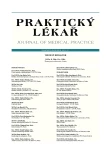International research of palliative care for dementia patients
Authors:
M. Stolička; R. Bužgová
Authors‘ workplace:
Vedoucí: doc. PhDr. Darja Jarošová, Ph. D.
; Ústav ošetřovatelství a porodní asistence
; Lékařská fakulta
; Děkan: doc. MUDr. Arnošt Martínek, CSc.
; Ostravská univerzita, Ostrava
Published in:
Prakt. Lék. 2012; 92(6): 346-351
Category:
Of different specialties
Overview
The aim of this study was to find and analyse the research on the issue of palliative care for patients with dementia. As a source of data, the following databases were used (1990–2011): Medline, EBSCO, Bibliomedica, ProQuest, Google Scholar, The Cochrane Collaboration. Twelve research studies and one systematic survey were included in the analysis. These studies dealt with some of the following topics: decision-making in palliative care, identifying quality of life and quality of care, problems of self-harming, estimation of survival and palliative sedation. Problems such as nutritional support, hydration and the use of restraints are the most common issues surrounding the critical decisions. The family participates in the decision to start antibiotic therapy, tracheal suction, the initiation or discontinuation of artificial nutrition and hydration infusions. Most of these critical decisions affect patient quality of life and the length of survival. An active solution to the identified problem is usually prefered than a decision to withhold or stop treatment. At the end of life, the quality of care is usually evaluated by the levels of symptoms (pain, shortness of breath, agitation and problems with food - difficulty in swallowing and loss of appetite). Improving the quality of life requires adequate treatment of pain, shortness of breath, problems with nutrition, and the recognition and treatment of behavioural disorders.
In the case of seniors with dementia the problem of pain is much less often solved and they are less frequently indicated for hospice care. Assessment tools for quality of care are important in order to evaluate the functional status of terminally ill patients, nutrition assessment and cognitive status, prognostic tools for predicting survival and assessment tools for quality of life.
Key words:
palliative care, patients with dementia
Sources
1. Caron, Ch.D., Griffith J., Arcand, M. Decision making at the end of life in dementia: how family caregivers perceive their interactions with health care providers in long-term-care setting. J Appl Gerontol, 2005, 24(3), p. 231–247.
2. Cordner, Z., Blass, D.M., Rabins, P.V., Black, B.S. Quality of life in nursing home residents with advanced dementia. J Am Geriatrics Soc, 2010, 58(12), p. 2394–2400.
3. Curiale, V. World-wide literature survey on geriatric palliative medicine. Eur Geriatr Med, 2011, 2, p. 6–11.
4. DeJonghe-Rouleau, A.P., Pot, A.M., DeJonghe, J.F. Self-injurious behaviour in nursing home residents with dementia. Int J Geriatr Psychiatry, 2005, 20(7), p. 651–657.
5. Evers, M., Purohit, D., Perl, D., et al. Palliative and aggressive end-of-life care for patients with dementia. Psychiatr Serv, 2002, 53(5), p. 609–613.
6. Froggatt, K., Vaughan, S., Bernard, C. et al. Advance planning in care homes for older people: a survey of current practice. Lancaster: International Observatory on End of Life Care, 2008.
7. Hersh, M., Nazarian, M.A. Palliative care can help reduce incidence of Medicare’s never-events for dementia patients. J Hosp Palliat Nurs, 2010, 12(4), p. 247–254.
8. Holley, A.P.H, Gorawara-Bhat, R., Dale, W. et al. Palliative access through care at home: Experiences with an Urban geriatric home palliative care program. J Am Geriatrics Soc, 2009, 57(10), p. 1925-1931.
9. Kiely, D.K., Givens, J.L., Shaffer, ML. et al. Hospice use and outcomes in nursing home residents with advanced dementia. J Am Geriatrics Soc, 58(12), p. 2284–2291.
10. Luchins, D.J., Hanrahan, P., Murphy, K. Criteria for enrolling dementia patients in hospice. J Am Geriatrics Soc, 1997, 45, p. 1054–1059.
11. Mitchell, S.L., Kiely D.K., Hamel, M.B. Dying with advanced dementia in the nursing home. Arch Intern Med, 2004, 164, p. 321–326.
12. Mitchell, S.L., Miller, S.C., Teno, J.M. et al. The advanced dementia prognostic tool: a risk score to estimate survival in nursing home residents with advanced dementia. J Pain Symptom Manage, 2010, 40(5), p. 639–651.
13. Moody, L.E., Small, B.J., Jones, Ch.B. Advance directives preferences of functionally and cognitively impaired nursing home residents in the Unites States. J Appl Gerontol, 2002, 21(1), p. 103–118.
14. Pidrman, V. Demence. Praha: Grada, 2007. 183 s. ISBN 978-80-247-1490-5.
15. Sampson, E.L. Palliative care for people with dementia. Br Med Bull, 2010, 96, p. 159–174.
16. Simionato, L., DiGiulio, P., Dimonte, V. et al. Decisions affecting quality of life or survival for severely demented persons: A survey on doctors and nurses of nursing homes and districts. J Hosp Palliat Nurs, 2010, 12(6), p. 378–384.
17. Sloane, P.D., Zimmerman, S., Williams, CH.S., Hanson, LC. Dying with dementia in long-term care. Gerontologist, 2008, 48(6), p. 741–751.
18. VanDeijck, R., Krijnsen, P., Hasselaar, J. et al. The practice of continuous palliative sedation in elderly patients: a nationwide explorative study among Dutch nursing home physicians. J Am Geriatrics Soc, 2010, 58(9), p. 1671–1678.
Labels
General practitioner for children and adolescents General practitioner for adultsArticle was published in
General Practitioner

2012 Issue 6
- Memantine in Dementia Therapy – Current Findings and Possible Future Applications
- What Effect Can Be Expected from Limosilactobacillus reuteri in Mucositis and Peri-Implantitis?
- Memantine Eases Daily Life for Patients and Caregivers
- Metamizole vs. Tramadol in Postoperative Analgesia
- Metamizole at a Glance and in Practice – Effective Non-Opioid Analgesic for All Ages
Most read in this issue
- Diseases of the knee cartilage and the repair options
-
Základy kognitivní, afektivní a sociální neurovědy
XIX. Mozek a stres - Correlation of alcohol consumption and cigarette smoking
- Metallothionein and its role in detoxification of heavy metals and predisposition to diseases
